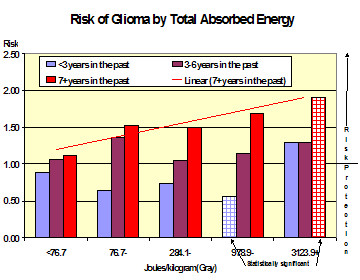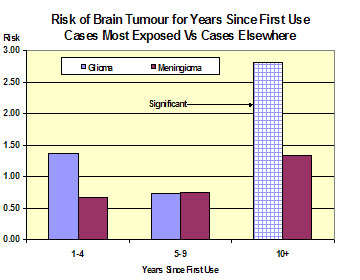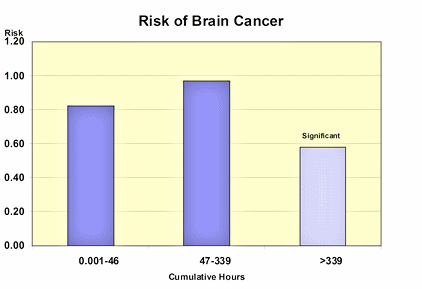 |
 |
|
 |
 |
About Us | Contact |
|
|
10/06/2011 - Mobile phones cause brain tumoursInterphone Study leader Elisabeth Cardis and colleagues have now published a new analysis showing an increased risk of brain cancer close to where you hold a mobile phone to your head [1]. This shows up in the data from people who have used a mobile phone for more than 7 years. The majority of malignant gliomas (the most common type that has been associated with mobile phone use) are fatal within 3 to 5 years of diagnosis, even with treatment. The new study claims to be the first to use estimates of RF energy absorbed at the centre of brain tumours as a measure of radio-frequency (RF) dose. An increased risk of glioma was seen in the 20% of users with the highest exposure. When risk was examined as a function of dose received over time before diagnosis, an increasing trend (p < 0.01) was observed with increasing RF exposure as a result of mobile phone use for more than 7 years. Our results suggest that there may be an increase in risk of glioma in the most exposed area of the brain among long-term and heavy users of mobile phones.
Table 1 in the paper reports, for more than 15 mins per day (735 total hours) of mobile phone use, a statistically significant 72% increase of brain cancer. Their Table 2 reports a 66% increased risk of brain cancer by the total absorbed energy at the location of the tumor though, oddly, offers significant protection from developing a meningioma. A "risk" below 1.00, is a reduced risk or a protective effect. As you can see findings at two levels of cumulative absorbed cellphone radiation show a significant protective finding. This incongruous finding is an artifact of the Interphone study's protocol, which has 14 design flaws each resulting in an under-estimation or dilution of risk. See [15 Reasons]. Probably the worst of these design flaws was that while every study subject was asked if they used a cordless phone, cordless phone use was treated as a non-exposure. During the years of the Interphone study, typically there were more cordless phone users than mobile phone users. More recent research [2] has indicated that mean weekly exposure to all RF-EMF sources was mainly due to mobile phone base stations (32%), mobile phone handsets (29%) and digital enhanced cordless (DECT) phones (23%). So Mobile phone handset use accounts for less than one-third of all RF exposure. This is probably the largest reason we see the "false" protective effect in the Interphone results.Another design flaw is "selection bias". When randomly selected controls are ask to participate in a mobile phone study, controls who use a mobile phone agree to participate in greater numbers than controls who do not use a mobile phone. The Interphone study has confessed to this flaw, stating that, in their opinion, it results in a 10% underestimation of risk. An alternative view from the other interphone groups - a seven country study
The cumulative hours of mobile phone use is much shorter than in the Cardis study with the highest category being over 10 minutes per day (>339 hours total) compared to Cardis' 25 minutes per day average (>1,147 hours total). The graph shows the results for this seven country study. Somewhat surprisingly, even though this is a case-case analysis, for >339 cumulative hours there is significant protection from brain cancer. The worst design flaw, treating cordless phone exposure as a non-exposure, may be the explanation. They chose to use a "case-specular" analysis technique. They describe this as follows, "in a case-specular analysis, a hypothetical reference location was assigned for each glioma, and the distances from the actual and specular locations to the handset were compared". For more than 10 years use, even this analysis shows a 100% increase in risk of brain cancer. This finding does not match the protective effect found for the highests hours of use. Given the larger number of cases included in this study (873) compared to the smaller number in the five-country study (808), the sparseness of their reported results is telling, as is the exclusion of meningioma without explanation. One of the listed authors is Professor Anders Ahlbom who was summarily removed from the IARC meeting because of undisclosed conflict-of-interest problems. Ahlbom has now resigned as Chairman of Swedish Radiation Protection Authority. ConclusionsWith apparent open warfare among the various Interphone researcher groups, with the long-delayed, and still incomplete publication of the Interphone results, it is time for the release of the entire Interphone dataset to research teams who can publish these results in a timely manner, and whose analytical approaches are likely to be different. IARC has now determined that RF radiation, indeed the entire non-ionizing electromagnetic field spectrum from electrical power frequency up to and including 300 GHz is a possible human carcinogen. It is time that public health organisations take action. Specifically, in the context of these studies, the European Union and its member countries should begin a major public awareness campaign, up to and including warning labels on all wireless consumer products. Analysis and commentary by Lloyd Morgan and Alasdair Philips. References
Microwave News is keeping the world up to date on these developments - read the main news and the Short Takes here: "Latest Microwave News". |




 Most European Interphone study groups refused to let Cardis have their data for analysis. We do have to wonder why? This group has released their own study using completely different methodology from Cardis et al [3]. It only examined the risk of glioma and without explanation ignored risk of meningioma. The meninges surround the brain and absorb more cellphone radiation than brain tissue. Its basic approach, using a case-case design, was to examine the risk up to, or more than, 5 cm from the mobile phone. The measurement was defined as "the distance between the midpoint of the glioma and the presumed source of the exposure."
Most European Interphone study groups refused to let Cardis have their data for analysis. We do have to wonder why? This group has released their own study using completely different methodology from Cardis et al [3]. It only examined the risk of glioma and without explanation ignored risk of meningioma. The meninges surround the brain and absorb more cellphone radiation than brain tissue. Its basic approach, using a case-case design, was to examine the risk up to, or more than, 5 cm from the mobile phone. The measurement was defined as "the distance between the midpoint of the glioma and the presumed source of the exposure."